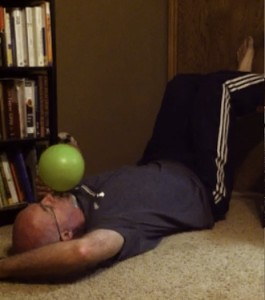Crunches?
No, that’s free (and not so good for your spine either).
Sit ups?
Same thing.
Or how about crunches on a Swiss Ball?
Well, a Swiss ball costs more than 30 cents and it’s not such a great drill for your lower back either.
No, what I’m thinking of, courtesy of the greatest athletic trainer I know, Stu Nichols, is something that you can use lying down, sitting down, or even walking.
A balloon.
Seriously.
But to give credit where it’s due, Stu told me he learned of the drill from Ron Hruska, PT of the Postural Restoration Institute. And this concept was recently published in the North American Journal of Sports Physical Therapy (( Boyle, K. L., J. Olinick, et al. “The value of blowing up a balloon.” N Am J Sports Phys Ther 5(3): 179-88. ))
But rather than transport you to snoozeville with all of the technical details of why this simple technique works, I think you should just try it (this is a slightly modified version from the one presented in the article – it works well though).
- Get a regular, 12″ party ballon. Cost is about 30 cents.
- Lie down on your back and place your feet up on the wall so you hips and knees are at 90 degrees. Hold the balloon with your left
 hand.
hand.
- For optimal results, place your right hand over your head.
- Inhale through your nose and as you exhale through your mouth in to the balloon.
- Now inhale through your nose and slowly blow out into the balloon.
- Without pinching the neck of the balloon, inhale again through your nose (you’ll have to use your tongue to block the air by placing it on the roof of your mouth).
- Slowly blow out as you stabilize the balloon with your left hand. This should be as relaxed as possible.
- After the fourth breath in, pinch the balloon neck and remove it from your mouth. Let the air out of the balloon.
- Relax and repeat the sequence 4 more times.
What happens when you blow up the balloon, without you having to think about it, is a coordination of both your abdominal muscles, chest muscles, and diaphragm. So not only will you get a flatter stomach (since the more you do this, the more toned these muscles become and will then, at rest, be tighter), you’ll also give your spine a bit more stability as well. We know that the deep abdominal muscles connect with the muscles in your spine that help guide the spine when you move. So, when you train the diaphragm and deep abdominals, you “wake up” the spinal stabilizer muscles too.
I’ve used imagery like blowing out a candle or, imagine someone is about to punch you in the belly and you need to brace for it (in fact this is one the foundational techniques you learn in my Build a Rock Solid Core book because bracing is so important to your overall functional health), but I think this technique, especially for people who learn by doing and by feeling, is better.
You can use this technique in sitting, standing, lying down and even while walking (yep, I use it while walking). One of the keys to it is to block the flow of air with your tongue. This creates extra abdominal control.
Give it a try and let me know what you think.

